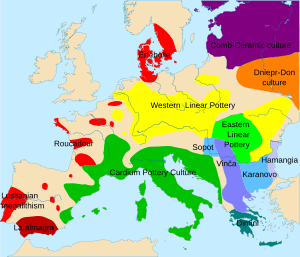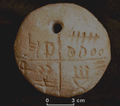Vinča culture facts for kids
The Vinča culture was an ancient civilization that lived a very long time ago. They existed during the Stone Age, which was a time before people used metal tools. This culture thrived from about 5400 BC to 4600 BC. That's over 7,000 years ago!
The Vinča culture is named after a large archaeological site. This site was found near the modern-day city of Belgrade in Serbia. Besides Serbia, signs of the Vinča culture have also been found in other countries. These include Romania, Hungary, and Bosnia.
Today, the Vinča culture is famous for its many ceramic figurines. These are small statues made from clay. Some of these figurines even have special symbols on them. People think these symbols might be an early form of writing. These mysterious marks are known as Vinča symbols.
Contents
Discovering the Vinča Culture
The Vinča culture was first discovered in the early 1900s. An archaeologist named Miloje Vasić started digging at the Vinča site in 1908. He found many interesting things there. These discoveries helped us learn a lot about this ancient civilization.
The main site, Vinča-Belo Brdo, is one of the largest Stone Age settlements in Europe. It shows that people lived there for a very long time. They built their homes on top of older ones, creating layers of history.
Life in the Vinča Culture
People of the Vinča culture lived in villages. Their homes were often made of wood and mud. They were farmers and grew crops like wheat and barley. They also raised animals such as cattle, sheep, and goats. This helped them get food and other resources.
The Vinča people were skilled craftspeople. They made tools from stone and bone. They also created beautiful pottery. Their pottery often had unique patterns and designs.
Early Metal Use
The Vinča culture was one of the first groups to learn how to work with copper. This was a very important step in human history. They started processing copper in the late 6th millennium BC. They didn't melt the copper yet, but they heated it and hammered it into shapes. This skill helped them make new types of tools and ornaments.
Art and Symbols
The most famous items from the Vinča culture are their clay figurines. These small statues show human-like figures. Some have detailed faces and clothing. Others are more abstract. Many of these figurines might have been used in religious ceremonies.
Some figurines and other objects have strange symbols carved into them. These are the Vinča symbols. They look like simple pictures or patterns. Scientists are still trying to figure out what these symbols mean. Some believe they are the earliest form of writing ever found. If true, this would mean writing started much earlier than we thought!
Why the Vinča Culture Ended
The Vinča culture slowly faded away around 4600 BC. The reasons for its end are not fully known. It might have been due to climate change or new groups of people moving into the area. However, their influence on later cultures in Europe was significant. They left behind a rich legacy of innovation and art.
Images for kids
See also
 In Spanish: Cultura de Vinča para niños
In Spanish: Cultura de Vinča para niños








